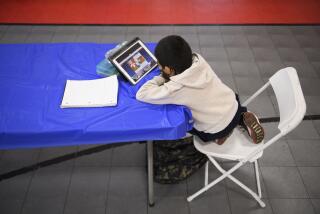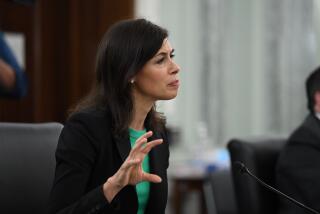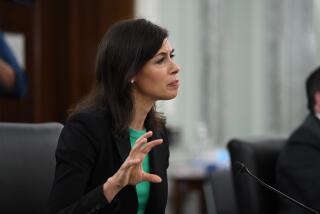An obscure battle over wireless airwaves comes to Trojan football
- Share via
When the USC football team plays Stanford at the Coliseum on Saturday, it won’t be hard to find Trojan fans with their game face on, or even with the team’s colors plastered all over their mugs. But a camera-toting squad from an advocacy group called WifiForward will be asking people at the stadium to show something else: their “What? No Wi-Fi?” face.
We all know how to make that one. The caps on mobile data plans have taught consumers to connect their smartphones and tablets to Wi-Fi instead of their mobile network whenever possible, especially when streaming video clips from YouTube or watching an episode of “Marvel’s Agents of Shield” on Netflix. (What, you don’t binge on “Agents of Shield”?) And when you’re on the road, it’s often a challenge to find an open Wi-Fi network that isn’t clogged with users.
But with its “Save Our Wi-Fi” campaign, WifiForward -- a coalition of giant Internet companies, device makers, cable TV operators and others that have invested heavily in Wi-Fi technology -- is trying to make a different point to federal policymakers: that the advanced version of Wi-Fi needs more airwaves, and that the ones it’s using today shouldn’t be taken over by other technologies that hog the bandwidth. Among other potential threats, the group is concerned about a high-speed data technology called LTE-U, which uses 4G mobile data protocols to transmit over the same 5 Ghz spectrum that higher-speed versions of Wi-Fi use.
Verizon Wireless has announced plans to offer LTE-U to business customers in selected cities in 2016, and T-Mobile has said it expects to run trials of the technology that year. Doing so would let users transmit data at better-than-Wi-Fi speeds and potentially in areas with poor Wi-Fi coverage, without having to log onto a different network. But a horde of tech companies, retailers and service providers that rely on Wi-Fi have complained about potential interference between the two technologies, prompting engineers at the Federal Communications Commission to launch an inquiry.
------------
FOR THE RECORD
An earlier version of this post said T-Mobile had said it would deploy LTE-U this year, but had put the rollout on hold after companies that rely on Wi-Fi complained about potential interference. A spokesman for T-Mobile said it had never committed to a 2015 rollout, but instead continues to plan to run trials with LTE-U in 2016.
------------
Wi-Fi has become vital to Internet users, for both its affordability and its ubiquity -- you’ll find it in a wide variety of devices, including computers, phones, televisions and appliances. According to WifiForward, most of the data produced by devices will run over Wi-Fi by 2019. The shift from wired and cellular to Wi-Fi has been encouraged by ever-increasing Wi-Fi speeds; the next version will have gigabit speeds and do a better job in areas crowded with devices.
But the airwaves used by Wi-Fi are unlicensed, which means there’s no guarantee that different users won’t interfere with one another. According to Ellen Satterwhite, a spokeswoman for WifiForward, industry standard-setting bodies have traditionally been the ones to solve that problem by coming up with protocols to ensure that the frequencies are shared equitably.
In the case of Wi-Fi, Satterwhite said, the standards call for devices to find an unused slice of bandwidth before transmitting anything, and to check periodically for other users in that channel. There’s no industry standard yet for the “coexistence mechanisms” that LTE-U uses, she said. And the proprietary techniques used in LTE-U don’t follow the Wi-Fi rules, she said, creating the possibility that LTE-U devices will crowd out Wi-Fi ones.
Nonsense, says Dean Brenner, senior vice president of government affairs for Qualcomm, a leading supplier of microchips for mobile devices. The LTE-U specification requires devices to look first for an open channel, Brenner said, and if they fail to find one, they have to use the least crowded channel -- and even then, only in proportion to the number of Wi-Fi devices in that channel.
Beyond that, Brenner said, many Wi-Fi devices don’t follow the letter of the Wi-Fi specifications when it comes to coexisting with other devices, creating the very problem that Satterwhite says LTE-U will cause. The mechanisms LTE-U uses were designed for how Wi-Fi routers and other wireless devices perform in the real world, he said, not how they’re supposed to perform.
Each side is touting tests that show there is or isn’t an interference problem. Here’s one from the cable TV industry -- a big Wi-Fi user -- that warns about the problems LTE-U will cause. And here’s research by Qualcomm showing that replacing some Wi-Fi access points with LTE-U actually helps improve Wi-Fi speeds.
Clearly, this is just the type of stuff that football fans want to sink their teeth into between bites of burger and sips of light beer. Or not. Regardless, five-person teams from the Save Our Wi-Fi campaign will be snapping pictures at the USC-Stanford game, as well as Notre Dame’s home game against Georgia Tech on Saturday. The images they capture of disgruntled Wi-Fi users will help spread word of the campaign through social media.
One thing both sides can agree on is that having more unlicensed spectrum would be a good thing. And another thing both sides should be able to agree on is that having a common, independently certified approach to sharing unlicensed spectrum would help resolve disputes such as this one. It would also help assure that consumers and business users will be the ultimate arbiters of how unlicensed airwaves will be divided -- not incumbents intent on protecting their market share or upstarts unwilling to play nice with others.
The dispute between Wi-Fi and LTE-U factions might require the intervention of the FCC, which would be unfortunate. Because the last thing anyone should want is for the government to impose mandates on airwaves that were supposed to be left wide open to innovation.
Healey writes editorials for the L.A. Times. Follow his intermittent Twitter feed: @jcahealey.
MORE FROM BUSINESS
Burberry turns to Snapchat before runway to debut London Fashion Week show
Making a Halloween costume? Seedling Comic Studio app creates a digital version
In-home tech-support provider HelloTech expanding beyond L.A. with new funding







